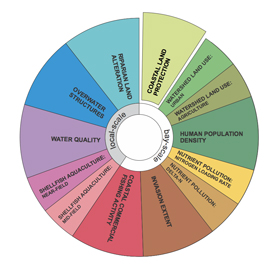Lush seagrass beds that support marine life, store carbon and prevent coastal erosion are on the decline due to such things as farming, aquaculture and coastal development.
Now, researchers at AVŠŃ└ų▓┐ and Fisheries and Oceans Canada have come up with a new way to measure the extent of human activities on this important ecosystem.
The team, part of the , developed a ŌĆśreport cardŌĆÖ or metric to assess the degree of 12 land- and sea-based activities on coastal ecosystems like seagrass meadows, kelp forests and rockweed beds, which provide food and shelter to a variety of animals.
Grace Murphy, a postdoctoral researcher in the Department of Biology, says the metric includes a range of activities on land, near shore and in the bays themselves.
ŌĆ£We found that 64 per cent of all bays in our study are at risk of seagrass decline based on nitrogen loading rates,ŌĆØ according to her paper, published in the science journal FACETS.
ŌĆ£Global declines in seagrass cover and associated ecosystem health have been attributed to various human activities, including nutrient pollution, the spread of invasive species, coastal land alteration and aquaculture.ŌĆØ
Revealing the range of impacts
 The metric was applied to 180 seagrass beds in 52 bays throughout the Atlantic region. Researchers found that land alteration, nutrient loading and shellfish aquaculture were higher in the Gulf of St. Lawrence, while invasive species and fishing were higher along the Atlantic coast.
The metric was applied to 180 seagrass beds in 52 bays throughout the Atlantic region. Researchers found that land alteration, nutrient loading and shellfish aquaculture were higher in the Gulf of St. Lawrence, while invasive species and fishing were higher along the Atlantic coast.
The results reveal a wide range in the intensity of impacts, providing insight into where coastal bays and seagrass beds are most affected by human activities and need management attention. For example, in Prince Edward Island and New Brunswick many seagrass beds are influenced by high nitrogen loading from farming runoff. The Island was determined to have the highest risk of so-called eutrophication ŌĆō a phenomenon in which increased nutrients are released into coastal waters, leading to harmful algae blooms, fish kills and dead zones.
Dr. Murphy says that despite the metric revealing many high-impacted seagrass beds, the results also show where coastal bays and seagrass beds are least affected by human activities and would be ideal places for protection and conservation.
╠²
ŌĆ£Our metric can be applied to coastal ecosystems worldwide and can be used to prioritize areas for protection and management by identifying areas of low and high impact,ŌĆØ the papers states.
Protecting ecosystems
Management agencies have recognized the importance of protecting the plant-based ecosystems, and many countries are including them in marine protected areas or other conservation zones.
But Dr. Murphy says it remains unclear how to select areas for protection or other management measures given the wide variety and different intensities of human activities along the coasts. She hopes the impact metric they have developed will be used by marine managers to identify areas that are good candidates for protection.
In Canada, eelgrass has been designated an Ecologically Significant Species and its inclusion in marine protected areas has been made a key conservation priority.

